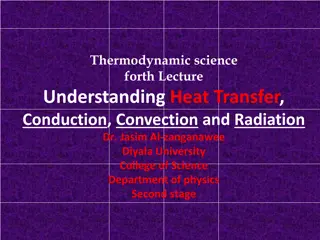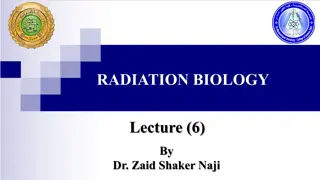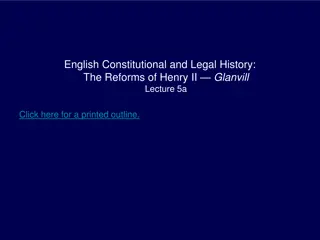Understanding NP-Completeness: Cook-Levin Theorem and Clique Problem
Today's lecture delved into NP-completeness, focusing on the Cook-Levin Theorem and the Clique Problem. NP-completeness is defined as a language that is in NP and all other languages in NP are polynomial-time reducible to it. The Cook-Levin Theorem states that SAT, a Boolean satisfiability problem, is NP-complete. The lecture discussed the importance of NP-completeness in showcasing computational intractability and providing insights into proving P versus NP.
Download Presentation

Please find below an Image/Link to download the presentation.
The content on the website is provided AS IS for your information and personal use only. It may not be sold, licensed, or shared on other websites without obtaining consent from the author. Download presentation by click this link. If you encounter any issues during the download, it is possible that the publisher has removed the file from their server.
E N D
Presentation Transcript
18.404/6.840 Lecture 15 Last time: - NTIME ? ? , NP - P vs NP problem - Dynamic Programming, ?CFG P - Polynomial-time reducibility Today: (Sipser 7.5) - NP-completeness
Quick Review Defn: ? is polynomial time reducible to ? (? P?) if ? m? by a reduction function that is computable in polynomial time. Theorem: If ? P? and ? P then ? P. ? ? ? ? is computable in polynomial time NP = All languages where can verify membership quickly P = All languages where can test membership quickly ? P versus NP question: Does P = NP? P NP P = NP ??? = ? ? is a satisfiable Boolean formula} Cook-Levin Theorem: ??? P P = NP Proof plan: Show that every ? NP is polynomial time reducible to ???.
P Example: 3??? and ?????? Defn: Defn: A Boolean formula ? is in Conjunctive Normal Form (CNF) if it has the form ? = ? ? ? ? ? ? ? (? ?) clause clause literals Literal: Literal: a variable or a negated variable Clause: Clause: an OR ( ) of literals. CNF: CNF: an AND ( ) of clauses. 3CNF: 3CNF: a CNF with exactly 3 literals in each clause. 3??? = ? ? is a satisfiable 3CNF formula} Defn: Defn: A ?-clique in a graph is a subset of k nodes all directly connected by edges. ?????? = ?,? graph ? contains a ?-clique} 3-clique Will show: 3??? P?????? 4-clique 5-clique
3??? P?????? Theorem: Theorem: 3??? P?????? Proof: Give polynomial-time reduction ? that maps ? to ?,? where ? is satisfiable iff ? has a ?-clique. A satisfying assignment to a CNF formula has 1 true literal in each clause. ? = ? ? ? ? ? ? ? ? ? ? ? ? ? ? ? ? ? ? ? ? ? . . . = ? ? ? ? ? ? has all non-forbidden edges Forbidden edges: 1) within a clause 2) inconsistent labels (? and ?) ? = # clauses
3??? P?????? conclusion ? = ? ? ? ? ? ? ? ? ? ? ? ? ? ? ? ? ? ? ? ? ? . . . ? ? = = # clauses ? ? ? ? Check-in 15.1 Does this proof require 3 literals per clause? (a) Yes, to prove the claim. (b) Yes, to show it is in poly time. (c) No, it works for any size clauses. Claim: Claim: ? is satisfiable iff ? has a ?-clique ( ) Take any satisfying assignment to ?. Pick 1 true literal in each clause. The corresponding nodes in G are a ?-clique because they don t have forbidden edges. ( ) Take any ?-clique in ?. It must have 1 node in each clause. Set each corresponding literal TRUE. That gives a satisfying assignment to ?. The reduction ? is computable in polynomial time. Corollary: Corollary: ?????? P 3??? P Check-in 15.1
NP-completeness Defn: ? is NP-complete if 1) ? NP 2) For all ? NP, ? P? next lecture NP If ? is NP-complete and ? P then P = NP. P??? P3??? P?????? today P??????? Cook-Levin Theorem: ??? is NP-complete Proof: Next lecture; assume true To show some language ? is NP-complete, show 3??? ??. or some other previously shown NP-complete language Check-in 15.2 Importance of NP-completeness 1) Showing ? is NP-complete is evidence of computational intractability. 2) Gives a good candidate for proving P NP. (a) ?TM (b) ?TM (c) 0?1? ? 0} What language that we ve previously seen is most analogous to ???? Check-in 15.2
??????? is NP-complete Theorem: ??????? is NP-complete Proof: Show 3??? ???????? (assumes 3??? is NP-complete) Idea: Simulate variables and clauses with gadgets ? = ?1 ?2 ?3 ?1 ?2 ?4 ? ? ?,?,? ?1 clause gadget . . . variable gadget Zig-zag Zag-zig Corresponds to setting ?1 TRUE Corresponds to setting ?1 FALSE
Construction of ? ? = ?1 ?2 ?3 ?1 ?2 ?4 ?? ?? ?1 ?2 ? variables ? clauses ? ? ?1 ?1 . . . . . . ?2 ?1 negated in ?2 . . . The reduction ? is computable in polynomial time. ?2 . . . . . . ?? Check-in 15.3 Would this construction still work if we made ? undirected by changing all the arrows to lines? In other words, would this construction show that the undirected Hamiltonian path problem is NP-complete? Claim: Claim: ? is satisfiable iff ? has a Hamiltonian path from ? to ?. ( ) Take any satisfying assignment to ?. Make corresponding zig-zags and zag-zigs through variable gadgets from ? to ?. Make detours to visit the clause nodes ??. ( ) Take any Hamiltonian path from ? to ?. Show it must be zig-zags and zag-zigs with detours to visit all ??. Get corresponding truth asst. It must satisfy ? because path visits all ??. . . . ?? . . . (a) Yes, the construction would still work. (b) No, the construction depends on ? being directed. ? Check-in 15.3
Quick review of today 1. NP-completeness ???and3??? 2. 3??? ???????? 3. 3??? ??????? 4. 5. Strategy for proving NP-completeness: Reduce from 3??? by constructing gadgets that simulate variables and clauses.























